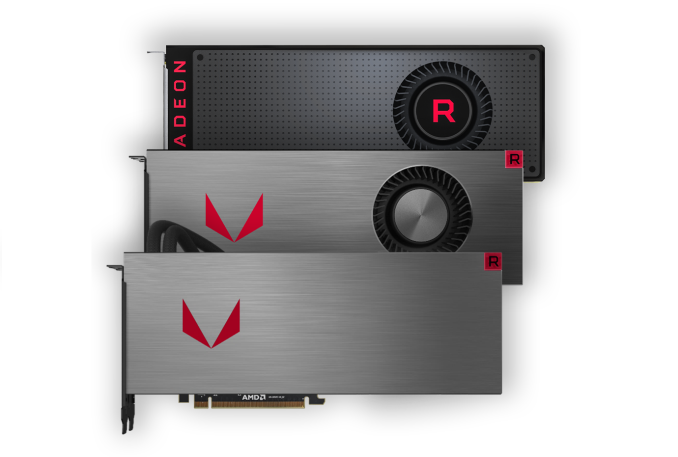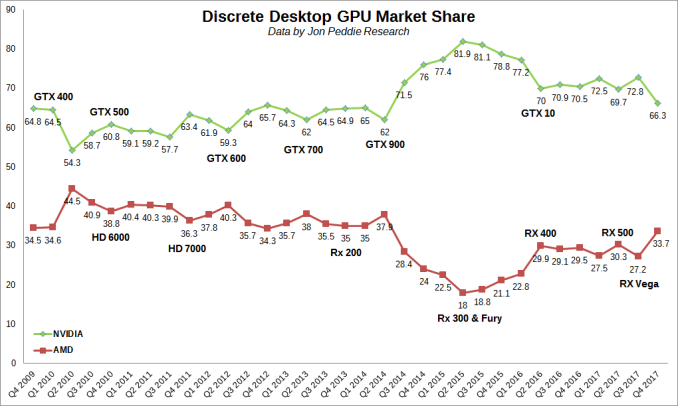Cryptomining Inflated Prices Affect Q4 2017 Discrete Graphics Card Shipments, AMD Climbs to 33.7% Market Share
by Nate Oh on March 1, 2018 9:00 AM EST
This week, Jon Peddie Research (JPR) released their much anticipated quarterly discrete video card sales report for Q4 2017.
Overall, the research firm is reporting a 4.6% decrease in graphics add-in board (AIB) shipments from last quarter. According to JPR, this is in line with their seasonal ten-year Q3-to-Q4 average of -4.4%; and yet despite this, Q4 was hardly a normal quarter in the industry. As many long-time readers are already well aware, Q4 is when GPU cyrptocurrency mining came back with a vengeance, and indeed without mincing words, the report attributed Q4 2017’s figures to a combination of cryptocurrency mining demand inflating average selling prices, as well as seasonality.
Interestingly it's arguably the latter point that's the more salient. While cryptocurrency prices have affected prices, the long ramp-up/ramp-down cycle for beginning-to-end video card production means that the industry can't radically alter volumes inside a single quarter. In other words, GPU manufacturers and their partners have to plan for the quarter in advance, and a typical Q4 plan would involve tapering back on production a bit to match the traditional seasonal demand.
In total, JPR estimates that over three million graphics cards were sold to cryptocurrency miners, adding up to $776 million in sales. Of these sales, AMD benefitted the most - as one might expect from their early performance advantage in cryptocurrency mining performance. As a result, AMD’s discrete desktop graphics market share is up 6.5 percentage points from Q3 2017, increasing to 33.7%, while NVIDIA’s stands at 66.3%.
| Discrete Desktop GPU Market Share Data by Jon Peddie Research |
|||||
| Q4'2017 | Q3'2017 | Q4'2016 | |||
| AMD | 33.7% | 27.2% | 29.5% | ||
| NVIDIA | 66.3% | 72.8% | 70.5% | ||
In the public report, it was not specified how much of the market share change was attributable to disproportionate mining sales. Nevertheless, this brings AMD’s share to the highest it has been since Q2 2014. Including all desktop and notebook GPUs, market share remains fairly similar to last quarter, with AMD picking up 1.2%, Intel down 0.4%, and NVIDIA down 0.9%. AMD’s overall GPU shipments were up 8.08% from last quarter, while Intel’s total shipments were down 1.98% and NVIDIA’s down 6%.
| Total GPU Market Share Data by Jon Peddie Research |
|||||
| Q4'2017 | Q3'2017 | Q4'2016 | |||
| AMD | 14.2% | 13.0% | 14.4% | ||
| Intel | 67.4% | 67.8% | 68.1% | ||
| NVIDIA | 18.4% | 19.3% | 17.5% | ||
| Change in GPU Unit Shipments by Segment Data by Jon Peddie Research |
||||
| Quarterly Change | Annual Change | |||
| Discrete Desktop | -4.6% | 9.7% | ||
| Desktop Integrated and Embedded | 3.0% | -8.3% | ||
| Desktop Total | -0.1% | -2.1% | ||
| Discrete Notebook | 3.6% | -5.6% | ||
| Notebook Integrated and Embedded | -3.7% | -6.8% | ||
| Notebook Total | -2.3% | -6.5% | ||
| All Total | -1.45% | -4.8% | ||
JPR did note that the high-end ($250+) and mid-range ($150 – 249) segments continue to expand, while the lower-end mainstream ($90 – 149) stagnates. Though not part of the report itself, this trend is consistent with higher-end cards being favored for mining due to better performance per watt and per dollar. At the same time there's some natural pressure as well: as integrated graphics capabilities improve, this trend is likely to persist. Just last month AMD released their new generation of APUs, with graphics performance of the Ryzen 5 2400G on par with the entry-level discrete graphics.
| Graphics Segment Market Share Data by Jon Peddie Research |
||||
| Q4'2017 | Q4'2016 | |||
| Mainstream ($90 - $149) | 26.1% | 39.2% | ||
| Mid-range ($150 - $249) | 51.7% | 41.5% | ||
| High-end ($250+) | 16.0% | 11.5% | ||
| Workstation | 6.3% | 7.8% | ||
As far as cryptomining demand goes, JPR expects the tapering off to continue, and otherwise remain volatile, an outlook similar to those of both NVIDIA and AMD. However, JPR warns that “[inflated AIB] prices will not drop in the near future.” The decline has not been straightforward, and NVIDIA stated for their recent quarterly report that cryptomining contributed more to revenue than last quarter on a percentage basis; in context, NVIDIA had accounted cryptomining board sales to total to around $70 million for fiscal Q3 2018 and $150 million for fiscal Q2. Compounding matters is the ongoing GDDR5/HBM2 memory shortage, which is further bottlenecking video card production.
In their respective quarterly financial calls, both GPU vendors reiterated their focus on consumer gaming over cryptocurrency mining. Though ultimately neither vendor has the ability to completely restrict sales to a single group due to the nature of the open market.
Source: Jon Peddie Research












51 Comments
View All Comments
willis936 - Thursday, March 1, 2018 - link
Is it possible that no GPU manufacturer openly supports cryptocurrency mining because they don't have to? No marketing has to be done to people buying cards for profit. They'll buy what's available that makes them the most money. Gamers are a fickle market and have a sour disposition towards cryptocurrency mining because they cause a scarcity and increased price in GPUs. So as a GPU manufacturer you'd want to say nothing or even publicly denounce cryptocurrency mining while actually doing nothing to prevent it. In reality the GPU manufacturers don't care who buys their cards as long as they're selling as many as possible.zlandar - Thursday, March 1, 2018 - link
Except the cryptocurrency craze stinks like an unsustainable bubble. Do you think Nvidia and AMD are going to gamble billions in capital expenses to increase production? What about their regular customers who are mostly PC gamers? Maybe some of those customers will get turned off by the sky-high GPU prices and switch to console gaming never to return.If they are smart they will care and protect their core consumer base instead of chasing after digital chits.
PeachNCream - Thursday, March 1, 2018 - link
"Maybe some of those customers will get turned off by the sky-high GPU prices and switch to console gaming never to return."That's basically me in a nutshell. I can buy a $300-400 console for games and keep using my existing PC for non-gaming chores without worrying about upgrades for a number of years. In the future, I can buy the latest generation of console and a new and inexpensive laptop (which will still be used for whatever games happen to run on the IGP) for less than the price of a mid-range gaming desktop. It was already difficult to justify video games on a PC before the GPU, RAM, and SSD prices all surged last year. Now, I can't do it at all so I've given up and don't plan to revisit serious computer gaming in the foreseeable future.
Threska - Thursday, March 1, 2018 - link
Till someone finds a way to turn a console into a miner.WinterCharm - Thursday, March 1, 2018 - link
DO NOT SPEAK OF SUCH EVIL!haukionkannel - Thursday, March 1, 2018 - link
Hmmm... Sounds a good idea! Consoles Are fast for the price! Because the makers hope that They will make money by selling games, so consoles would be excelent for bang for the bug crypto mining... and the price point of the consoles raise upp in 5, 4, 3, 2, 1, 0....Dragonstongue - Thursday, March 1, 2018 - link
they are SLOW for crypto purposes, XB1 and PS4 are using 7870 generation graphics, if one bought one of these for ONLY this purpose, you would be lucky to break even at best (not to mention 7870 I know for a FACT is just not able to be used anymore for most crypto mining purposes)They "seem powerful" because it is a locked out system "tuned" to run what they run and nothing more, but, for base example, Phenom II x6 1035T (comparable considering performance of the cpu side current gen consoles use) and Radeon 7850/7870 (underclocked I might add) while one can still "game on" them, are NOT at all "powerful"
lmcd - Friday, March 2, 2018 - link
At the moment it's probably cost efficient to buy an XBox One X for its graphics capabilities.mode_13h - Sunday, March 11, 2018 - link
You're thinking of the OG versions. PS4 Pro and XBox One X are like RX 570 and RX 580, respectively.forgerone - Thursday, March 1, 2018 - link
Why not? Console clusters certainly have been built before.